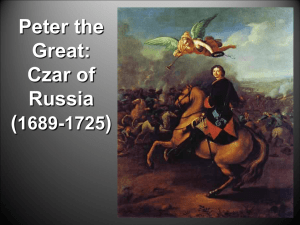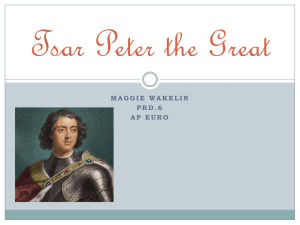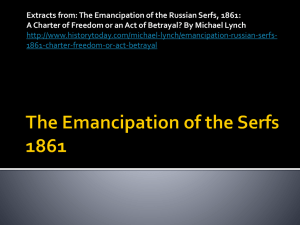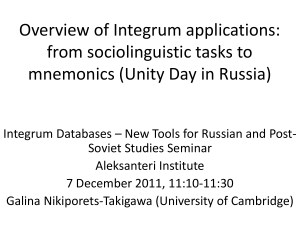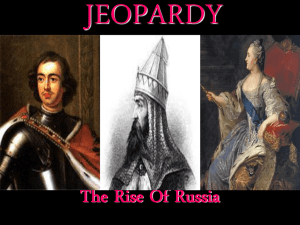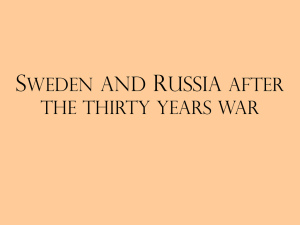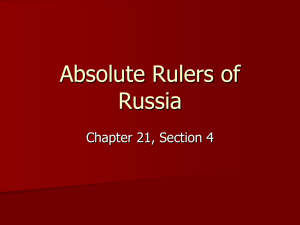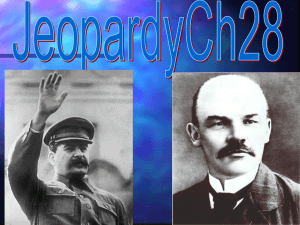Absolute Monarchy in Russia
advertisement
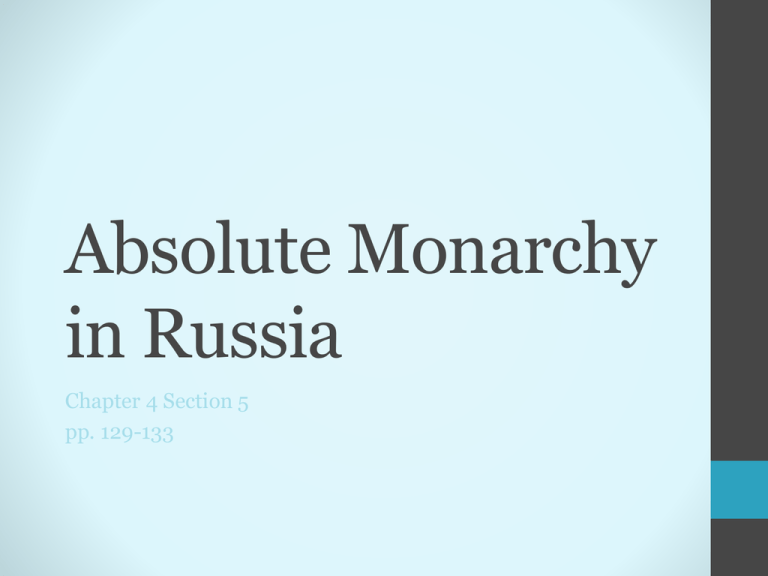
Absolute Monarchy in Russia Chapter 4 Section 5 pp. 129-133 Peter the Great • Peter was just 10 years old when he claimed the throne • Took control of government in 1689 • Not very educated • Very curious • Spent hours in “German Quarter” • Moscow suburb where Dutch, Scottish, English, and other foreign artisans and soldiers lived • Heard of the advanced technology in Western Europe Journey to the West • 1697- Peter sent out to study western technology • • • • Spent hours walking the streets of European cities Visited factories and art galleries Learned anatomy A dentist taught him how to pull teeth • Peter was impressed by England’s parliament • Peter brought back a group of technical experts, teachers, and soldiers back to Russia • Embarked on policy of westernization • Russians weren’t easily persuaded • Peter became the most autocratic of Europe’s absolute monarchs Autocrat and Reformer • Peter pursued several related goals • Wanted to strengthen the military • Expand Russian borders • Centralized royal power • To achieve his goals, he brought all Russian institutions under his control • Including the Russian Orthodox Church • Forced boyars to serve the state in civilian or military jobs Autocrat and Reformer cont. • Serfdom spread long after it had died out in Western Europe • Peter pushed through social and economic reforms • Imported western technology • Improved education • Simplified science and engineering • To pay for reforms, he adopted mercantilist policies • Like encouraging exports • Improved water-ways and canals, developed mining and textile manufacturing, backed new trading companies Autocrat and Reformer cont. • Changes had symbolic meaning • Peter insisted boyars shave their beards • Forced them to replace their old-fashioned robes with Western European clothes • Ended the practice of secluding upper-class women in separate quarters • Held grand parties where women and men were expected to dace together • Russian nobles resisted the radical mixing of men and women in public • Peter had no mercy for those you resisted • Over 1,000 rebels were tortured and executed when elite palace guards revolted • As an example of his power, he left the rotting corpses outside the palace walls for months Expansion Under Peter • Peter worked to build Russian’s military power • Created the largest standing army in Europe • Set out to extend Russian borders to the west and south Search for a Warm-Water Port • Russian seaports were frozen during the winter • Located in the Arctic Ocean • Peter wanted a warm-water port to increase Russia’s ability to trade with the West • Nearest warm-water port was located along the Black Sea • To gain control of this territory, he had to push through powerful Ottoman empire • Peter was unable to defeat them in the end • A later Russian monarch, Catherine the Great, would achieve that goal before the century ended War With Sweden • 1700- Peter began a long war against the kingdom of Sweden • Sweden dominated the Baltic region • Swedish force had only 8,000 men and defeated the Russian force which was five times its size • Peter rebuilt the army along western lines • 1709- he defeated Swedes and won land to the Baltic Sea Peter’s City • Peter built magnificent capital city on land won from Sweden • Called St. Petersburg • Located the city on the swampy shores of the Neva River near the Baltic coast • Wanted to open a window on the West • Forced tens of thousands of serfs to drain the swamps • Many died, but Peter got his city • Peter then invited Italian architects and artisans to design palaces in western style • St. Petersburg became a symbol of Peter’s desire to forge a modern Russia Toward the Pacific • Russian traders and raiders crossed the plains and rivers of Siberia toward the Pacific • Russia sign a treaty with Qing China defining their common border in the east • Treaty recognized Russia’s right to lands north of Manchuria • Early 1700s- Peter hired the Danish navigator, Vitus Bering, to explore what was later known as the Bering Strait between Siberia and Alaska • Russian pioneers crossed into Alaska and migrated as far south as California • Not many Russians moved east of the Ural Mountains • Russia was already the largest country in the world, and still is Legacy of Peter the Great • Peter died in 1725 • Left behind a mixed legacy • • • • He expanded Russian territory Gained ports on the Baltic Sea Created a better army Ended Russia’s long period of isolation • From the 1700s on, Russia was increasingly involved in affairs of Western Europe • Many of his reforms died with him • Nobles soon ignored his policy of service to the state • Peter the Great brandished terror to enforce his power • Polices contributed to the growth of serfdom • Widened the gap between Russia and the West the Peter had sought to narrow Catherine the Great • Peter died without naming a successor • Set off power struggles • Catherine the Great took the throne • She was a German princess by birth • Came to Russia at 15 to wed the heir to the Russian throne • She learned Russian, embraced the Russian Orthodox faith, and won the loyalty of the people • 1762- her mentally unstable husband, Czar Peter III, was murdered by a group of Russian army officers An Efficient Ruler • Catherine proved to be an efficient and energetic empress • Reorganized the provincial government, codified laws, and began state-sponsored education for both girls and boys • She embraced western ideas • Encouraged French language and customs at court • Wrote histories and plays • Organized court performances • She was a serious student of the French thinkers who led the intellectual movement • Known as Enlightenment A Ruthless Absolute Monarch • Catherine granted a charter to the boyars outlining rights • Such as exemption from taxes • When peasants rebelled, she took firm action to repress them • As a result, conditions grew worse for Russian peasants • Catherine was determined to expand Russia’s borders • Achieved Peter’s dream of a warm-water port on the Black Sea after a war against the Ottoman empire • Took steps to seize territory from Poland Partition of Poland • Polish rulers were unable to centralize their power • The divided Polish government was ill prepared to stand up to Russia, Prussia, and Austria • 1770’s- Catherine the Great, Frederick the Great, and Emperor Joseph II of Austria agreed to partition Poland • 1772- Catherine took part of eastern Poland • Many Russians and Ukrainians lived there • Frederick and Joseph got lands to the west Partition of Poland cont. • 1793- Poland was partitioned again and for a third time in 1795 • By that time Austria, Prussia, and Russia had taken the land they wanted • Poland had vanished from the map • 1919- Free Polish state would reappear Looking Ahead • Mid-1700s- Absolute monarchs ruled four of the five leading powers in Europe • Britain was the only exception • The five nations often ended up fighting to maintain the balance of power • Radical changes soon shattered the French monarchy, upset the balance of power, and revolutionized European societies Vocabulary • Westernization- Adoption of Western Europe’s ideals and technology, as in Russia • Boyar- Russian Nobles • Warm-Water Port- Port free of ice all year long, Russia longed for this • Partitioned- to be Split Up Review Questions • What Russian Czar was 7ft tall? Peter the Great • What spread in Russia dealing with low class people that had been all but abolished in Europe? Serfdom • What was Peter the Greats new capital city? St. Petersburg • Who became the leader of Russia after her husband Peter III was assassinated? Catherine the Great • By the mid 1700s what was the only major country in Europe not ruled by an Absolute Monarch? Great Britain/England
